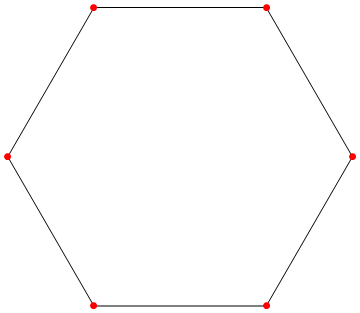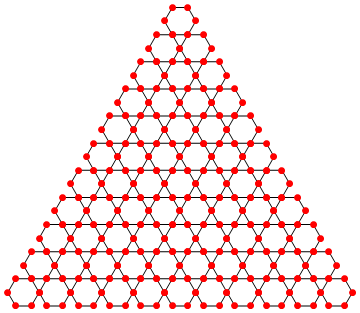We can construct a hexagon with short edges (with length 1) and long edges (with length β >= 1) using AnglePath as follows:
ClearAll[diamondcoords, diamond]
diamondcoords[β_: 1] := AnglePath @
Thread[{{1, β, 1, β, 1, β}, {0, 1, 1, 1, 1, 1} 2 Pi / 6}]
diamond[β_: 1] := {AbsoluteThickness[10], CapForm["Round"],
MapIndexed[{{Red, Blue}[[Mod[#2[[1]], 2, 1]]], Line @ #} &,
Partition[diamondcoords[β], 2, 1]],
Gray, AbsolutePointSize @ 7, Point @ diamondcoords[β]}
With default value (β = 1) we get a regular hexagon:
Row[{Graphics[diamond[], ImageSize -> Medium],
Graphics[diamond[2], ImageSize -> Medium],
Graphics[diamond[4], ImageSize -> Medium]}]

We translate diamond[β] to get a tiling of desired size:
ClearAll[translations]
translations[n_] := Prepend[{0, 0}][Join @@
(Thread[{Range[-#, #, 2], -# }] & /@ Range[n])]
Graphics[Translate[diamond[],
-# {1/2, 1} (Subtract @@@ CoordinateBounds[diamondcoords[]])] & /@ translations[5],
ImageSize -> Large]

Graphics[Translate[diamond[2],
-# {1/2,1} (Subtract @@@ CoordinateBounds[diamondcoords[2]])] & /@ translations[7],
ImageSize -> Large]

Graphics[Translate[diamond[3],
-# {1/2, 1} (Subtract@@@CoordinateBounds[diamondcoords[3]])] & /@translations[5],
ImageSize -> Large]

Graphics[Translate[diamond[1/3],
-# {1/2, 1} (Subtract@@@CoordinateBounds[diamondcoords[1/3]])] & /@ translations[5],
ImageSize -> Large]










